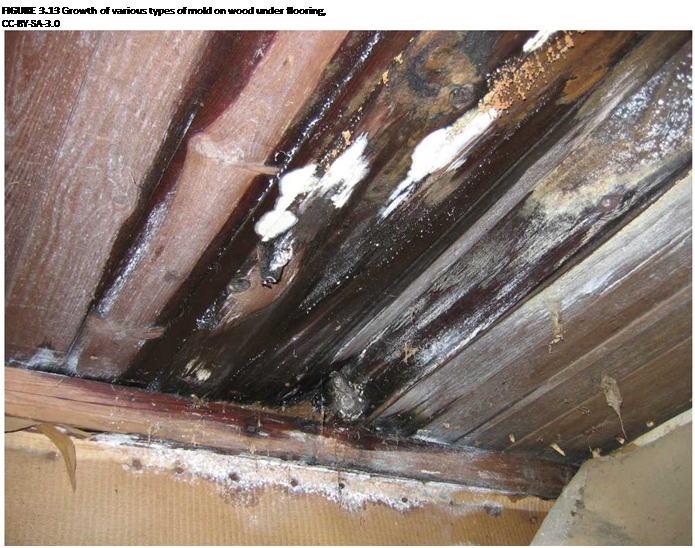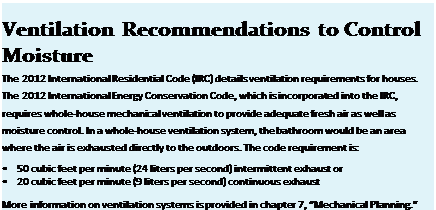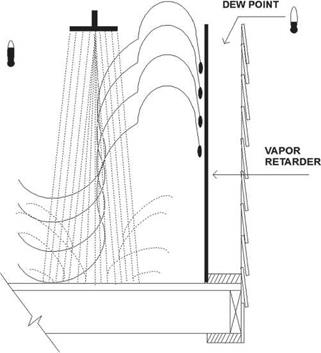Molds are fungi. There are thousands of varieties of molds, which reproduce by spores that are blown out into the air. The spores can be dormant for years. Then, given the right conditions of food and moisture, they can begin to grow.
At any given time, there are usually mold spores in the air around us. Molds are a natural part of the ecosystem and play an important role in digesting organic debris, such as dead leaves, insects, and wood. The problem occurs when there is an excess of mold growth, and the organic matter they are digesting is part of the building structure.

Molds require moisture, oxygen, and food to grow. How much of each of these elements is required depends on the mold variety. However, most will start growing at a relative humidity of 70 percent or more. Molds can make food out of almost any organic matter, including skin cells and residues from shampoo.
Cellulosic building materials such as paper, wood, textiles, many types of insulation, carpet, wallpaper, and drywall make an excellent environment for mold growth (see Figure 3.13). The cellulosic materials absorb moisture, providing the right growth conditions, and the materials themselves provide the food.
Molds grow fast. If cellulosic building materials get wet, mold growth will begin in 24 to 48 hours. Mold growth on the surface of noncellulosic materials can start in the same time period, as long as food and moisture are present.
Molds can affect people in different ways. Some people are allergic to specific species. Molds produce chemicals that are irritants to most people, and can cause problems such as headaches, breathing difficulties, and skin irritation, as well as aggravating other health conditions such as asthma. Molds can sensitize the body so that someone becomes more susceptible to health effects from future exposures. Finally, some molds produce toxins. The likelihood of health effects increases with the amount of exposure to mold, and also depends on the sensitivity of the individual.
Preventing Moisture Problems
Good ventilation is absolutely necessary to prevent moisture problems and mold growth in the bathroom. Exhaust ventilation removes excess moisture and prevents condensation. Ventilation systems are discussed in more detail in chapter 7, "Mechanical Planning." The importance of moisture control in a laundry area that might be part of a bathroom is discussed in chapter 9, "More Than a Bathroom." Closets, dressing areas, and linen closets that might be part of or adjacent to bathrooms are also discussed in chapter 9. Good ventilation for moisture control in these areas, especially for doors, is stressed.
 |
Finish materials can contribute to, or help prevent, moisture problems. After exposure to water and humidity, the more absorbent the materials, the longer they will stay damp. Specifying hard surface or nonabsorbent materials such as glazed tiles, solid surfacing, vitreous china, or engineered stone reduces the likelihood of moisture problems. Materials that stay damp are much more likely to support mold growth. Specifying sealers for absorbent or porous materials, such as clay tiles, marble, or grout, can also reduce moisture absorption.
 |
 |
It is especially important that wall and ceiling finishes or materials block the flow of moisture into wall cavities or attics. This can be accomplished by selecting materials that are not moisture permeable, such as glazed tiles or vinyl wall coverings. Additionally, a vapor retarder material, such as plastic sheeting, can be used in the wall construction (see Figure 3.14). There are special considerations about the placement of a vapor retarder, depending on whether the climate is dominated by heating or cooling. The vapor retarder is placed on the warm side to the wall. In a climate that is dominated by a heating season or has both heating and cooling, that is the interior side. In a hot climate that is dominated by the cooling season, the vapor retarder is usually placed on the exterior side of the wall.
Low-maintenance materials, fixtures, and fittings are also important. Materials that are kept clean are less likely to accumulate surface debris that can support mold growth. Avoid fixtures and fittings with cracks, seams, crevices, and indentations that can accumulate residue from skin, body oils, grooming products, and cleaning products—all organic materials that provide food for molds.
Antimicrobial Finishes
Some products, especially textiles, are available with various types of antimicrobial finishes or additives. Generally, an antimicrobial finish means that the material is treated with a pesticide of some sort to protect the material or product itself. For example, paints are available with fungicides to protect the paint from mold growth in the paint itself. This does not mean that mold will not grow on the paint, in a moist environment, if a food source such as skin cells or shampoo residues were to accumulate on the painted surface. Antimicrobial products may be desirable to minimize mold or bacterial problems, but will not be an adequate substitute for good maintenance and moisture control practices. There are also some concerns about the safe use of antimicrobial products that are classified as pesticides.
Towel Bars
Damp towels can be ideal environments for mold growth, which can lead to musty odors. Plan adequate towel bars, rings, and hooks for all bathroom users. Good air circulation around towels provides for quick drying. Consider placing towel bars near heat registers. Heated towel bars not only provide luxuriously warm towels after a shower or bath, but can also speed drying and thus prevent musty odors.
SUMMARY
Sustainable design benefits your client as well as the community as a whole. Sustainability is a philosophical approach that guides design and business decisions. Sustainability in the built environment encompasses energy efficiency, water management, air quality, waste management, and recycling. To be sustainable also means to provide a healthy place to live.
Sustainability can be practiced many different ways. Options include specifying products and materials or following practices that qualify for a national or local green building program. Alternatively, specifying products and materials that have been certified by an independent, third-party organization can be a sustainable choice. Another option is to follow the recommendations of the model International Energy Conservation Code.
The designer who makes sustainability a priority uses the various codes, standards, certifications, and guidelines to be informed and knowledgeable on products, policies, and practices. The goal is always to use resources efficiently, to think to the future, and to be concerned about the health and safety of the client.
REVIEW QUESTIONS
1. Describe three building or design practices that incorporate the goals of sustainability. (See "Sustainable Design and Building" page 65)
2. Describe a green building program. (See "Green Building Programs" page 68)
3. If a designer wants to specify sustainable products, how can product certifications assist the process? (See "Sustainable Certification Programs" page 71)
4. Explain how conserving water also saves energy. (See "Hot Water" page 76)
5. Summarize the requirements for a product to achieve the WaterSense certification. (See "WaterSense" page 79)
6. What are the steps to providing good indoor air quality? (See "Air Quality" page 81)
7. Explain why mold is a particular problem in the bathroom and a threat to a healthy home. (See "Molds, Moisture, and Health" page 87)
8. What types of information of use to the bathroom designer would be found in the 2012 International Residential Code? (See "Energy Issues and Building Codes" page 73)




